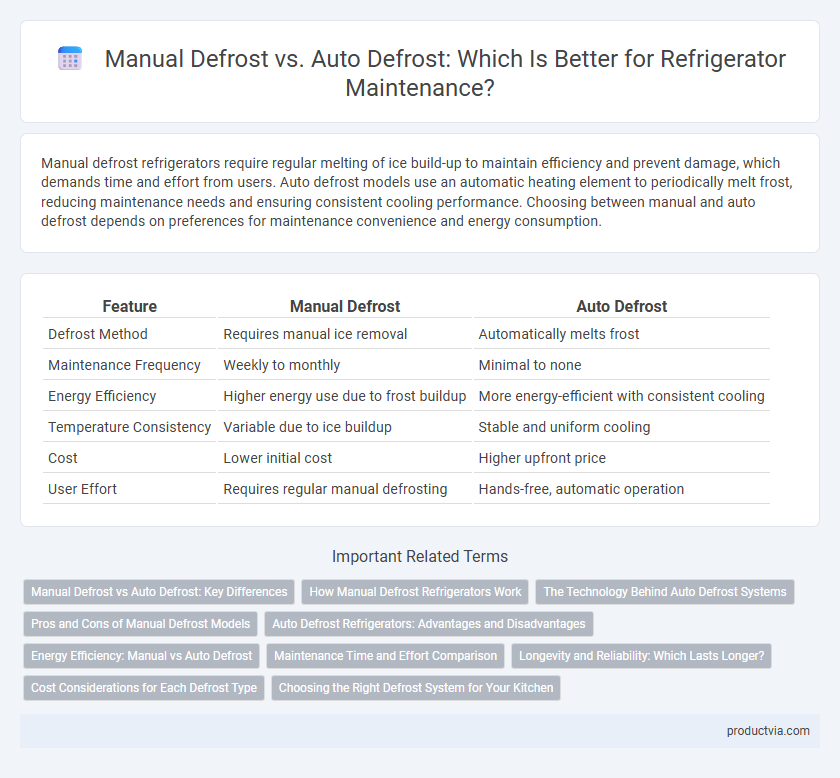Manual defrost refrigerators require regular melting of ice build-up to maintain efficiency and prevent damage, which demands time and effort from users. Auto defrost models use an automatic heating element to periodically melt frost, reducing maintenance needs and ensuring consistent cooling performance. Choosing between manual and auto defrost depends on preferences for maintenance convenience and energy consumption.
Table of Comparison
| Feature | Manual Defrost | Auto Defrost |
|---|---|---|
| Defrost Method | Requires manual ice removal | Automatically melts frost |
| Maintenance Frequency | Weekly to monthly | Minimal to none |
| Energy Efficiency | Higher energy use due to frost buildup | More energy-efficient with consistent cooling |
| Temperature Consistency | Variable due to ice buildup | Stable and uniform cooling |
| Cost | Lower initial cost | Higher upfront price |
| User Effort | Requires regular manual defrosting | Hands-free, automatic operation |
Manual Defrost vs Auto Defrost: Key Differences
Manual defrost refrigerators require periodic draining of frost buildup by turning off the appliance, which can be time-consuming but offers more energy efficiency. Auto defrost models use built-in heating elements to melt frost automatically, reducing maintenance but increasing energy consumption and noise. Choosing between manual and auto defrost involves balancing convenience against operational costs and long-term maintenance needs.
How Manual Defrost Refrigerators Work
Manual defrost refrigerators require users to periodically turn off the appliance to allow accumulated frost to melt, preventing ice buildup that can reduce cooling efficiency. These units rely on natural thawing processes without internal heating elements, meaning maintenance involves physically removing melted water and wiping down the interior. This method conserves energy by avoiding the constant operation of defrost heaters found in auto defrost models but demands more user involvement for optimal performance.
The Technology Behind Auto Defrost Systems
Auto defrost refrigerators utilize advanced sensors and heating elements to periodically melt frost buildup without user intervention, enhancing convenience and energy efficiency. These systems incorporate timers and thermostats that activate defrost cycles at optimal intervals, preventing ice accumulation on evaporator coils. This technology reduces manual maintenance, ensures consistent cooling performance, and prolongs the appliance's lifespan compared to manual defrost models.
Pros and Cons of Manual Defrost Models
Manual defrost refrigerators offer energy efficiency and quieter operation since they lack automatic defrost heaters, reducing electricity consumption and noise levels. These models require regular user intervention to melt accumulated ice, which can be time-consuming and may lead to temperature fluctuations if neglected. However, manual defrost units typically have fewer mechanical components, resulting in lower repair costs and longer lifespan compared to auto defrost systems.
Auto Defrost Refrigerators: Advantages and Disadvantages
Auto defrost refrigerators prevent ice buildup by periodically melting frost, reducing the need for manual maintenance and ensuring consistent cooling performance. They often feature energy-efficient technologies but may consume slightly more power due to the defrost cycle. However, the defrost process can cause minor temperature fluctuations and occasional noise, which some users may find inconvenient.
Energy Efficiency: Manual vs Auto Defrost
Manual defrost refrigerators consume less energy because they eliminate the need for a heating element to melt frost, which reduces electricity usage. Auto defrost models regularly activate a built-in heating coil to prevent ice buildup, leading to higher energy consumption and increased utility costs. Choosing manual defrost can improve overall energy efficiency and lower monthly energy bills while requiring periodic user intervention.
Maintenance Time and Effort Comparison
Manual defrost refrigerators require regular, time-consuming de-icing sessions that demand physical effort to remove ice buildup, often taking several hours every few months. Auto defrost models significantly reduce maintenance time by using automatic heating elements to prevent ice accumulation, allowing for minimal user intervention and consistent cooling efficiency. Choosing auto defrost systems saves substantial effort and helps maintain optimal appliance performance with less frequent upkeep.
Longevity and Reliability: Which Lasts Longer?
Manual defrost refrigerators tend to have fewer mechanical components, which often results in greater longevity and reliability due to less wear and tear. Auto defrost models offer convenience by preventing ice build-up but incorporate more parts like defrost heaters and timers that may increase the risk of malfunctions over time. For users prioritizing long-term durability, manual defrost technology generally lasts longer with proper maintenance.
Cost Considerations for Each Defrost Type
Manual defrost refrigerators generally have lower upfront costs and consume less energy during operation, making them budget-friendly appliances for cost-conscious consumers. Auto defrost models typically come with higher initial prices and increased energy use due to built-in defrost heating elements, but they reduce maintenance time and prevent frost buildup. Evaluating energy efficiency ratings and long-term electricity expenses is essential when comparing cost implications between manual and auto defrost refrigerator systems.
Choosing the Right Defrost System for Your Kitchen
Manual defrost refrigerators require regular ice removal, which can be labor-intensive but offers greater energy efficiency and longer food preservation. Auto defrost systems prevent frost buildup automatically, reducing maintenance needs and providing consistent cooling performance ideal for busy kitchens. Selecting the right defrost system depends on balancing convenience, energy consumption, and how frequently you want to manage maintenance tasks in your kitchen.
Manual Defrost vs Auto Defrost for Refrigerator Maintenance Infographic

 productvia.com
productvia.com